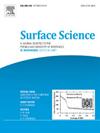Rationalizing the “anomalous” electrochemical Stark shift of CO at Pt(111) through vibrational spectroscopy and density-functional theory calculations
IF 1.8
4区 化学
Q3 CHEMISTRY, PHYSICAL
引用次数: 0
Abstract
We employ infrared reflection absorption spectroscopy (IRRAS) and first-principles density-functional theory (DFT) to revisit the reported “anomalous” negative Stark shift of the CO stretch frequency at Pt(111) in aqueous electrolyte. Our comprehensive IRRAS measurements confirm the existence of a potential region with negative Stark shift around 0.5 V vs. the reversible hydrogen electrode, but only at a sufficiently high CO concentration in the electrolyte. As these are exactly the same conditions for the occurrence of a phase transition from a -3CO to a R23.4-13CO adsorbate structure, we explicitly compute the Stark shift for these two phases using DFT. Neither phase exhibits a negative Stark shift, but the absolute stretch frequencies of the atop CO in the two structures are slightly shifted with respect to each other. Remeasuring IRRAS with high resolution indeed reveals a doublet character of the absorption band in the potential region corresponding to the negative Stark shift. Separate fits of the two components then yield positive Stark shifts in quantitative agreement with the calculated values. The “anomalous” negative Stark shift simply arises from effectively fitting one component to a doublet spectral feature in a potential range with phase coexistence at the surface.

通过振动光谱和密度泛函理论计算来解释CO在Pt(111)上的“反常”电化学斯塔克位移
我们利用红外反射吸收光谱(IRRAS)和第一性原理密度泛函理论(DFT)重新审视了在Pt(111)水溶液中CO拉伸频率的“异常”负Stark位移。我们的综合IRRAS测量证实,与可逆氢电极相比,存在一个负斯塔克位移约0.5 V的电位区域,但只有在电解质中CO浓度足够高的情况下才存在。由于这些是从(2×2)-3CO到(19×19)R23.4°-13CO吸附质结构发生相变的完全相同的条件,我们使用DFT明确地计算了这两个相的Stark位移。两个相都没有表现出负的Stark位移,但两个结构中顶部CO的绝对拉伸频率相对于彼此有轻微的位移。用高分辨率重新测量iras确实揭示了与负斯塔克位移相对应的势区吸收带的双重特征。两个分量的单独拟合然后产生与计算值定量一致的正斯塔克位移。“异常”负斯塔克位移仅仅是由于在表面相共存的电位范围内有效地将一个分量拟合到双重光谱特征。
本文章由计算机程序翻译,如有差异,请以英文原文为准。
求助全文
约1分钟内获得全文
求助全文
来源期刊

Surface Science
化学-物理:凝聚态物理
CiteScore
3.30
自引率
5.30%
发文量
137
审稿时长
25 days
期刊介绍:
Surface Science is devoted to elucidating the fundamental aspects of chemistry and physics occurring at a wide range of surfaces and interfaces and to disseminating this knowledge fast. The journal welcomes a broad spectrum of topics, including but not limited to:
• model systems (e.g. in Ultra High Vacuum) under well-controlled reactive conditions
• nanoscale science and engineering, including manipulation of matter at the atomic/molecular scale and assembly phenomena
• reactivity of surfaces as related to various applied areas including heterogeneous catalysis, chemistry at electrified interfaces, and semiconductors functionalization
• phenomena at interfaces relevant to energy storage and conversion, and fuels production and utilization
• surface reactivity for environmental protection and pollution remediation
• interactions at surfaces of soft matter, including polymers and biomaterials.
Both experimental and theoretical work, including modeling, is within the scope of the journal. Work published in Surface Science reaches a wide readership, from chemistry and physics to biology and materials science and engineering, providing an excellent forum for cross-fertilization of ideas and broad dissemination of scientific discoveries.
 求助内容:
求助内容: 应助结果提醒方式:
应助结果提醒方式:


